 |
Number of editions: 25
1st edition: July 8, 1997
Updated: April 27, 2012
|

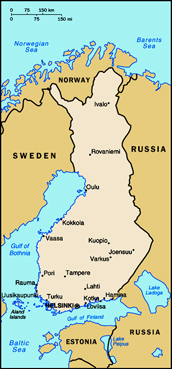
The early Finnish Monopoli editions of the Parker Brothers/Hasbro
company have been published by the Swedish licensee Alga thanks to
the close connections Finland always has had with Sweden. Besides Swedish is the
mother tongue of about 5.5% of the Suomi's population. The first Monopoli
editions where therefore bilingual but the later issues were in Finnish
only.
For some obscure reason Alga's mastery had been temporarilly been interrupted by
a company named Kuvataide OY.
Today Hasbro Nordic, with its seat in Glostrup - Denmark, distributes all
games, manufactured in the large European works in Waterford Ireland.
From Lähtö/Gå onwards the spaces of the bilingual
editions are:
Korkeavuorenkatu/Högbergsgatan - Yhteismaa/Allmänning (Community
Chest) - Kasarmikatu/Kaserngatan -
Tulovero/Inkomstskat (Income Tax) - Linjuri Asema/Buss
Station - Rantatie/Strandvägen
- Sattuma/Chans (Chance) - Kauppatori/Salutorget
- Esplanaadi- katu/Esplanadgatan
- Vankilassa käynti/I fängelse På besök (In
Jail) - Hämeentie/Tavastvägen -
Vesijohtolaito/Vattenledningsverket (Water Works) - Siltasaari/Broholmen
- Kaisaniemenkatu/Kaisaniemigatan - Sörnäisten Asema/Sörnäs
Station (a Metro Station) - Liisankatu/ Elisabetsgatan - Yhteismaa/Allmänning
- Snellmaninkatu/Snellmansgatan
- Unioninkatu/Unionsgatan - Vapaa Pysäköinti/Fri
Parkering (Free
Parking) - Lönnrotinkatu/
Lönnrotsgatan - Sattuma/Chans - Annankatu/Annegatan - Simonkatu/Simonsgatan
- Rautatie Asema/Järnvägs Station (Railway Station)
- Mikonkatu/
Mikaelsgatan
- Aleksanterinkatu/Alexandersg. -
Sähkölaitos/Elektricitetsverket (Electric Company) -
Keskuskatu/Centralgatan
- Mene vankilalaan/Gå till fängelset (Go to Jail) - Tehtaankatu/Fabriksgatan
- Eira/Eira - Yhteismaa/Allmänning - Bulevardi/Bulevarden
- Tavara Asema/Gods Station (Freight station) - Sattuma/Chans - Mannerheimintie/Mannerheimvägen
- Lisävero/Extra Skatt (Special Tax) and Erottaja/Skillnaden.
(Note: In the pre-war edition(s) there was no Mannerheimintie, but a Heikinkatu.
The
street was named in 1812 as Henrikinkatu /Henriksgatan after minister Robert
Henrik Rehbinber. In 1935 it was named Heikinkatu, and 1942 as Mannerheimintie
after the “war hero” C.G.
E. Mannerheim.)
The streets on the Parker/Hasbro game board also are those of the capital Helsinki
of course:
Korkeavuorenkatu - Yhteismaa (Community
Chest) - Kasarmikatu -
Tulovero (Income Tax) - Pasilan Asema - Rantatie
- Sattuma (Chance) - Kauppatori
- Esplanadi - Vankilassa käynti (In
Jail) - Hämeentie -
Sähkölaitos (Electric Company) - Siltasaari
- Kaisaniemenkatu - Sörnäisten Asema
(a MetroStation)
- Liisankatu - Yhteismaa - Snellmaninkatu
- Unioninkatu - Vapaa Pysäköinti (Free
Parking) - Lönnrotinkatu - Sattuma
- Annankatu - Simonkatu
- Rautatie Asema (Railway Station) - Mikonkatu
- Aleksanterinkatu -
Vesijohtotaitos (Water Works) -
Keskuskatu
- Mene vankilalaan (Go to Jail) - Tehtaankatu
- Eira - Yhteismaa - Bulevardi
- Tavara-Asema (Freight station) - Sattuma - Mannerheimintie
- Lisävero (Special Tax) and Erottaja.
 Edition: Monopoli/Monopol -
small black box with separate game board (1) Edition: Monopoli/Monopol -
small black box with separate game board (1)
Publisher: A.B.Finska Alga/Helsinki *
O.Y.Suomen Alga/Helsingfors - Tilgmann - ±1939
Copyright. A-B Alga Stockholm
Dimensions of the box: 19.5 x 16.2 cm
of the separate board: 49 x
48 cm
The game:
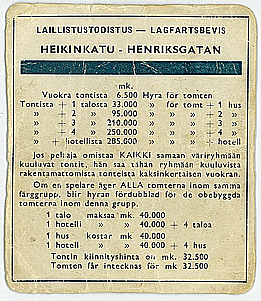 This edition is owned by Heikki Pietarinen -SF. His mother
got this set
This edition is owned by Heikki Pietarinen -SF. His mother
got this set
it in 1939, so before the war.
Although Heikki does not have the small box belonging to this game there is
no
doubt the publisher is the same as of the 1948 edition mentioned later.
On the other hand its age is fixed because of the fact the first street of the
last
colorgroup is named Heikinkatu, meaning the edition to be from
between
1935 and 1942.
Another striking point is the color bars of the property deeds being
narrower than usual. These cards have rounded corners.
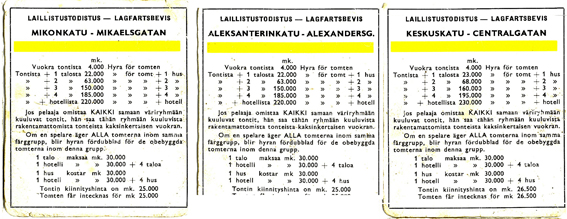
As was to be expected the rent for the unbuilt
yellow
street Keskuskatu is the same
(mk. 4.000) as for the other yellow
streets. This
mistake arose at the
start of this game in 1935
(the Atlantic City edition of
America) and was
consequently continued in all other countries.
This rent was adapted, i.a. made slightly
more
expensive, soon after 1985.
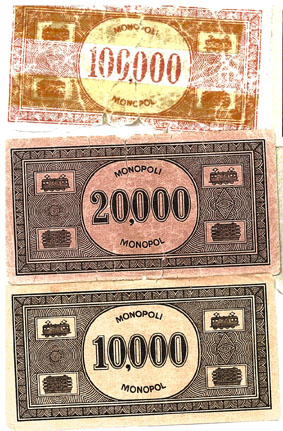
Other features of this edition are: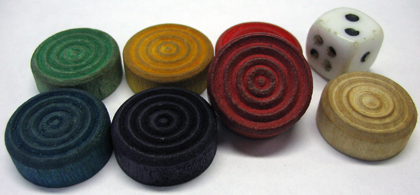
 |
The Sattuma/Chans cards (sizes: 52x90mm) are light
pink, the Yhteismaa/Allmänning cards are light
yellow.
The currency in the Finnish text of the cards is SMK (Suomi
Marka?) in the Swedish
wording FMK (Finska Marka?). |
 |
The 7 banknotes are sometimes printed in
color on white
paper and sometimes printed in black on colored paper.
Their denominations are resp.: 100
- 500 - 2,000 - 5,000 -
10,000
- 20,000 and 100,000
mk. Two of the small squares
show an electric locomotive, whereas the other 2
show
something that could perhaps be a hotel? |
 |
There are 6 tokens consisting of colored
draughtsmen. |
 |
The houses and hotels
are of dull wood. |
 |
The small, white plastic dice have black pips.
|
Edition: Monopoli/Monopol -
small black box with separate game board (2)
Publisher: A.B.Finska Alga/Helsinki *
O.Y.Suomen Alga/Helsingfors - Tilgmann - 1944
picture of the BOX
Copyright. A-B Alga Stockholm
Dimensions of the box: 19.5 x 16.2 cm
of the separate board: 49 x
48 cm
The game:
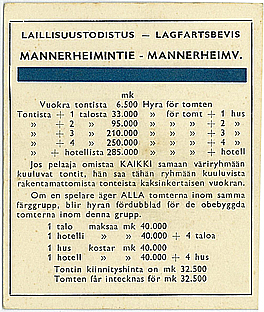 This edition is
also owned by Heikki Pietarinen-SF. This edition is
also owned by Heikki Pietarinen-SF.
This edition must have been published in 1944, or somewhat
earlier perhaps, because on the bottom of the box is written “to
jjyrki at Christmas 1944“.
The image on the lid only shows the name of Tilgmann,
reason to assume this set to be published by A.B.Finska Alga.
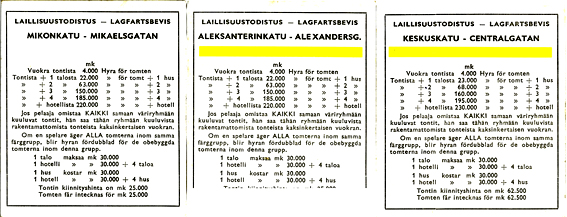
Within 5 years after the first edition the name
of the last property but one was
changed into
Mannerheimintie,
after the Finnish war hero
C.G.
E. Mannerheim.
Except for the fact that the rent of the unbuilt yellow
properties in this edition is also the same for all
3 streets the Mikonkatu property deed is a
misprint: it is missing the yellow
bar.
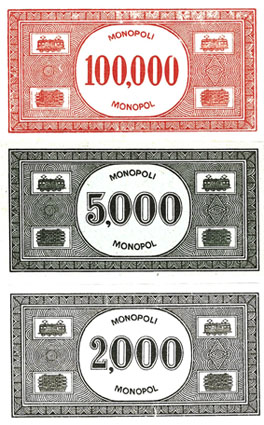 Almost
all other items are the same as of the 1939 edition, viz.: Almost
all other items are the same as of the 1939 edition, viz.:
 |
The Sattuma/Chans cards (sizes: 52x82 mm) are light
pink, the Yhteismaa/Allmänning cards are light
yellow. Now the currency is in
MK only in both languages of the cards. |
 |
The 7 banknotes are sometimes printed in
color on white paper and sometimes printed in black on colored paper.
Their denominations are resp.: 100
- 500 - 2,000 - 5,000 - 10,000
- 20,000 and 100,000 mk.
Two of the small squares show an electric locomotive, whereas the other 2
show something that could perhaps be a hotel? |
 |
There are 6 tokens consisting of colored
draughtsmen. |
 |
The houses and hotels
are of dull wood. |
 |
The small, white plastic dice have black pips.
|
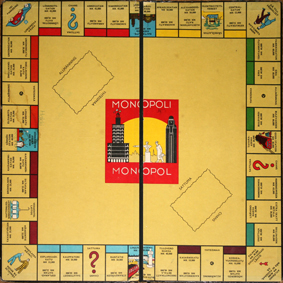 Edition: Monopoli/Monopol -
small black box with separate game board (3) Edition: Monopoli/Monopol -
small black box with separate game board (3)
Publisher: A.B.Finska Alga/Helsinki * O.Y.Suomen Alga/Helsingfors - Tilgmann -
1948
Copyright. A-B Alga Stockholm
Dimensions of the box: 19.5 x 16.2 cm
of the separate board: 49 x 48 cm
The game:
This is a funny story about how finally all pieces of a reseach fall together!
Risto
Kallio from Finland pointed me some time ago to this bilingual Monopoli
edition, of which he only had the game board. As I was
just in the
process of constructing chapter Sweden with the help of David Miller from the
U.K., having a lot of early Swedish editions, it
became clear this set had great
resemblance with the Swedish sets from the period 1937 till ±1950, because:
Risto
explains: The old central
busstation of Helsinki shows the text
Linjuri Asema. Asema
means Station, while Linjuri stands for Bus. In fact Linjuri is somekind of nick name
for a bus, because the real finnish translation for bus is Linja-auto. The word
Linjuri is no longer used these days. (That may be the reason why this station
has been replaced by the Pasilan Asema in later editions.)
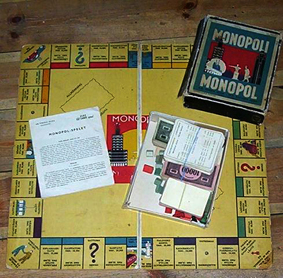  But
than it happened that David Miller obtained a complete set from
the tradera auction site But
than it happened that David Miller obtained a complete set from
the tradera auction site
with the same game board as Risto's.
Like in the early American and UK editions the whole set consists of a small
box for all
accessories as there are: the property deeds, the Sattuma-
and Yhteismaa cards, banknotes,
houses and hotels, tokens and dice and a
separate game board. The lid, as well as the centre
of the board, shows
an image with two large towers, the left one being that of the Torni
Hotel
and the right one representing the main railway station. In between are
two men underneath the
Monopoli arch, but in contrast to the image on the
Swedish editions they are now a traffic
controlling
policeman allowing a businessman to pass, rather then a "seller handing
over
a contract of sale to a buyer". These images are typical for the
interpretation of Monopoly by the
Alga designers.
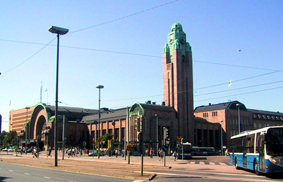 At
the end of both Rules it is found the manufacturer to be
Tilgmann and the year of publication At
the end of both Rules it is found the manufacturer to be
Tilgmann and the year of publication
1948! On top the Rules it says "Ett Alga-Spel".
The playside of the board is yellowish
green and its backside can be black or white. The fold
is perpendicular to the first side.
The property deeds (95x83 mm) have rounded corners. They are white, while
their backs have the mortgage information written in red.
The rent for the unbuilt yellow
street Keskuskatu is the same (mk. 4.000) as for the other yellow
streets.
The Sattuma cards (82x52 mm) are dark pink
through in color, the Yhteismaa cards very
light yellow.
There are only 6 Monopoly banknotes (95x52 mm), sometimes printed in
color on white paper and sometimes printed in black on colored paper.
Their denominations are resp.: 100
- 500 - 2,000 - 5,000 - 10,000
- 20,000 and 100,000.
The dull wood houses are light blue green,
the hotels red. This set had only 3 colored
wooden chess pawns for tokens.
Both dice are of brown wood with
white pips.
This edition was sold on www.tradera.com
for 162.- kr. (€ 17.40) Februari 2008.
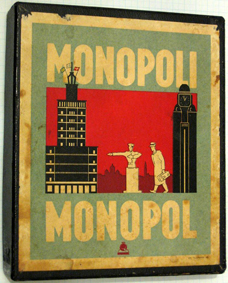 Edition: Monopoli/Monopol -
small black box with separate game board (4) Edition: Monopoli/Monopol -
small black box with separate game board (4)
Publisher: Kustantamo (publisher) Kuvataide OY - Helsinki
- OY Tilgmann AB - 1954
Dimensions of the box: 19.5 x 16.2 cm
of the separate board: 49 x 48 cm
The game:
This is another interesting edition Risto Kallio - SF came across. Its
year of publication was found at the end of the Rules pamphlet. These Rules do
not refer at all to Alga.
This bilingual edition is very similar to the one issued 1948, however
this one is not published by Alga but by a company named Kuvataide OY. It is
however, still manufactured by Tilgmann, the company who also made the Monopoli
edition of 6 years before!
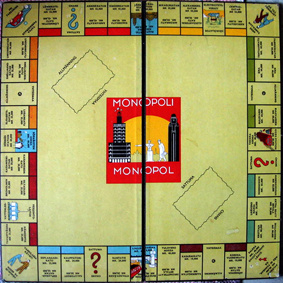 Only
manufacturer's name is mentioned on the lid and a small, red logo
of Kuvataide, the publisher. Only
manufacturer's name is mentioned on the lid and a small, red logo
of Kuvataide, the publisher.
The image on the sticker of the lid is the same as of Alga's edition.
The design of the game board and its illustrations haven't been changed.
Only the background color of the playside moved a bit to light blue
green and the colors of the property bars can slightly change.
It is
remarkable to see that the "bubbles and stars"-design hasn't
been applied yet, but that could have been done intentionally by the new
publisher?
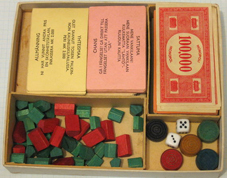 The
property deeds, Sattuma (Chance)- and Yhteismaa
(Community Chest) cards as well as the houses
and hotels are exactly the same as in the
earlier edition. The
property deeds, Sattuma (Chance)- and Yhteismaa
(Community Chest) cards as well as the houses
and hotels are exactly the same as in the
earlier edition.
The 7 banknotes almost have the Monopoly design, i.e. a central ellips
with a large number and the words Monopoli and Monopol and 4 little rectangles
with a figure. It is here where the notes deviate from the real Monopoly notes
of that period, because those rectangles 2 times show an electric locomotive and
twice an obscure image, where it ought to be resp. number - old locomotive -
house and number again. The
denominations are resp.: 100
- 500 - 2,000 - 5,000 - 10,000
- 20,000 and 100,000.
There are only 5 wood checkers as tokens in this edition, again a
remarkable deviation with respect to what was usual in Sweden.
The dice are white with black pips.
 Edition: Monopoli -
white box, Art.nr.1807 (1) Edition: Monopoli -
white box, Art.nr.1807 (1)
"Algan
kuuluisa liikemiespeli koko perheelle"
(Alga's
famous businessman game for the whole family)
© Parker Brothers Inc., USA och AB Alga Sweden (on the game
board only)
Publisher: Parker Bros.Inc./AB Alga Sweden - OY Fenno/Alga AB - ±1976
Dimensions of the box: 28.0 x 42.3 cm
of the board: 41.7 x 42.5 cm
The game:
This edition is owned by Päivi Martikainen - SF.
This new and colorful large box is very interesting for a
number of reasons, viz.:
 |
It is again an issue from Alga, now in cooperation with the
Finnish company Fenno. |
 |
This is the first time the size of the box was changed in
such a way that the game board fits inside. |
 |
Since 1961 Parker Brothers started to apply the same design
for its standard Monopoly editions all over the world.
The white lid shows a "game board in a green
in a blue square" with the red
Monopoli bar. (The
Swedish designers
however, have made a mistake,
because the game board in the green square is
the Swedish board, so with
the streets of Stockholm and Gå, instead of Lähtö). In
the blue square is a red
logo of OY Fenno/Alga AB.
In the lower left corner is the companies name, while in the lower right
corner is a red square with the
precursor of "Rich Uncle Pennybags".
On top the red bar is Parker
Bros./Alga's slogan in light blue
characters. |
 |

Although the Parker influence was increasing the design of the board
was just deviating from the Parker design: In order to indicate the difference between 2 groupes of
streets with the same color, the colors of 1 group are made different by bubbles,
stars and lines. The text
on the properties is shown twice so it can be read from all directions.
By the way, these issues are no longer bilingual.
With the picture:
In the Parker design the group of streets preceding the
Jail-corner have yellow
bars and the group around the corner have green
bars. Not so in the Alga design.
The
Vesijohtotaitos (Water Works) space show a bathtub
rather than a tap. (The
Sähkölaitos (Electric Company) space however do show
already a bulb, although not in the Parker design.)
The Yhteismaa (Community
Chest) spaces show a black §.
|
 |
The playfield of the board shows twice the image of
walking Rich Uncle Pennybags and the red
Fenno/Alga logo. |
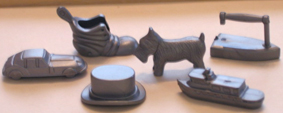 The rent on the unbuilt Keskuskatu (the
last street before Go To Jail) is still mk 400, which is the same as
on the 2 other streets of this group. The rent on the unbuilt Keskuskatu (the
last street before Go To Jail) is still mk 400, which is the same as
on the 2 other streets of this group.
The dimensions of the orange Sattuma- and blue Yhteismaa-cards
are 50
x 75 mm.
The 5 small Alga banknotes (50x87 mm) are one-sided printed on
colored paper. In the middle is the value in large figures and
thereunder the
neutral NO. 123456789. The denominations are resp.: 10 - 200
- 500 - 2000
and 10.000.
The 6 tokens are the well-known shoe - dog - iron
- hat - boat
and car, but made of grey plastic.
This was very unusual and therefore
of special interest for collectors?!
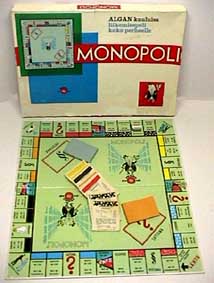
Edition: Monopoli -
white box, Art.nr.1807 (2)
"Algan
kuuluisa liikemiespeli koko perheelle"
(Alga's
famous businessman game for the whole family)
Publisher: Parker Bros.Inc./AB Alga Sweden - OY Fenno/Alga AB - 1977
Dimensions of the box: 28.0 x 42.3 cm
of the board: 41.7 x 42.5 cm
The game:
This set is owned by Kimmo and Minna Vaskimo in Zoetermeer - NL.
This edition is exactly the same in all details to the one
described before. The only exception is the tokens to be of light
metal now.
Given the large resemblance of this white box with the one of Art.Nr.92110/1 of
only a few years later it is interesting to compare both issues.
The lid:
|
Parker Bros. nr.92110/1 |
Alga nr.1807 |
|
Box is larger |
Box is broader |
In red
square with Uncle Pennybags
is the nummer 77314 |
Next to red
square with Uncle
Pennybags are no locomotives |
Lower left corner shows the
Parker swirl |
The blue
square shows the
Fenno/Alga logo |
Picture of the board corresponds
to the real
board |
Picture of the board does not correspond
to the real board |
The game board:
|
Parker Bros. nr.92110/1 |
Alga nr.1807 |
|
Sizes: 49 x 49 cm |
Sizes: 41.7 x 42.5 cm |
|
Back is red |
Back is white with green
spots |
Monopoli in closed, black characters
on the green midfield, parallel to
side 1 |
2x a picture with Monopoli in open
characters on top of Uncle Pennybags,
walking between houses, with the Fenno/Alga logo thereunder, on a yellow green board |
On the Community Chest spaces
is the well-known blue treasure
chest |
On the Community Chest spaces
is a black § |
The color bars of the properties are
as usual |
The color bars of the properties are
completely different |
The stations show the black Parker
locomotive |
3 stations show a red
train with each time
different people; the 4th one shows a
freight car with luggage in front |
| In Jail is the scoundrel behind bars |
In Jail the scoundrel welcomes a visitor in
a black suit |
| On Free Parking the red car has white tyres |
On Free Parking is a white open car next to
a parking sign |
| Water Works show a white cock |
Water Works show a bathtub |
| The Go To Jail field shows a blue policeman with wistle |
On the Go To Jail field a policeman takes
in a man with hat |
The Rules are printed on the inside of the lid, which is very practical
because this way they can never get lost.
There is nothing printed on the bottom of the box.
Over Lähtö you receive mk 4.000. The rent on the unbuilt Keskuskatu is still mk 400.
The dimensions of the orange Sattuma- and blue Yhteismaa
cards
are 50
x 75 mm.
The 5 small Alga banknotes (50x87 mm) are one-sided printed on
colored paper. In the middle is the value in large figures and thereunder the
neutral NO. 123456789. The denominations are resp.: 10 - 200
- 500 - 2000
and 10.000.
The 6 light metal tokens are the well-known: shoe - dog - iron
- hat - boat
and car.
 Edition:
Monopoli - Standard edition, Art.Nr.92110/1 Edition:
Monopoli - Standard edition, Art.Nr.92110/1
"Rek. tavaramerkii"
"Marknadeföres av PlayMix AB 28300 0696" (marketed
by PlayMix AB)
Publisher: Parker Bros./PlayMix AB - ±1980
Dimensions of the box: 26 x 51 cm
The game:
This edition does not have any "subtitle" on top the red
bar of the lid anymore. On the other hand it clearly shows the Parker
Swirl in the
lower left corner.
Although the last mentioned copyright year on the game board is 1961 it is most
likely this edition to be issued much later. Compared
to the same editions of
other countries, the innerboxes of which initially only partly had a cardboard
insert and the full red plastic insert -
containing 13 holes - came much later, I date this issue about ±1980.
Under the red bar on the lid is an
image of Uncle Pennybags in a red square
showing the number 77314 and a blue Parker
locomotive
o the left and right of this square.
The bottom of the box has a black/white picture of the so-called
inventor
Charles B. Darrow and the matching untrue story.
The midfield of the green board
with red back has Monopoli in closed black
characters parallel to side 1. Over Lähtö you receive mk 4.000. The light
blue
Sattuma cards (55x85 mm) and light pink
Yhteismaa cards have a repeating pattern of engine-Uncle Pennybags-engine
on their back.
The property cards with rounded corners (55x85 mm) have a white
back printed with red text. The rent of
the unbuilt Keskuskatu is mk
400.
The 7 Monopoly-banknotes (50x95 mm) show the mention “pat.app.for N°3796-36”.
They are printed in color on white paper and the denominations are: 50 - 200
- 500 - 1.000 - 5.000
- 2000
and 10.000.
The 8 tokens are the well-known: shoe - dog - wheel-barrow - iron
- hat - boat
- car and thimble.
The green houses and red
hotels are of hollow plastic and have overhanging roofs. Only the houses
have chimneys.
The dice are red with yellow
pips.
This issue was "Printed in France - F".
The price amounted to about US$ 40.- November 1985.
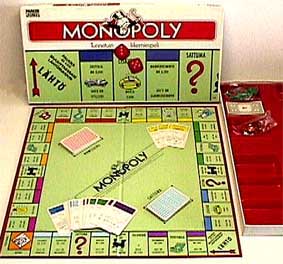 Edition:
Standard Monopoly, ref.1111 690224-SF Edition:
Standard Monopoly, ref.1111 690224-SF
Publisher: Parker Bros./Kenner - 1985
Dimensions of the box: 26 x 51 cm
The game:
Note that in this issue Monopoly is written with an y.
Like in other countries with this issue a more colorful
design is introduced. Under a red bar
with Monopoly in white characters, is the last part of the fourth side.
The rim of the lid show the red Monopoly bar
4 times.
The innerbox contains a solid insert of red
plastic devided in 13 holes for the banknotes and the other attributes. There is
nothing on the bottom of the box.
The blue green game board
shows the word Monopoly (with Uncle Pennybags) in closed characters in a
frame sloping over the midfield. The blue
Sattuma cards (55x85 mm) and pink Yhteismaa
cards have a repeating pattern of engine-Uncle Pennybags-engine on their
back. The property deeds with rounded corners (55x85 mm) have a white back
printed in red.
The rent of the unbuilt Keskuskatu is still mk 400. The names
of the streets are still mentioned twice on the spaces.
The banknotes show in the circle "Monopoli® - Monopoly® - Monopol®"
and "Copyright 1935 by Parker Brothers USA".
The 7 denominations are resp.: mk 20 -
50 - 100 -
500
- 1.000 - 2.000
and 10.000.
The 8 tokens are of metal and are now again: shoe - dog -
wheel-barrow - iron - hat - boat
- car and thimble.
The green
plastic houses have a chimney, the red
hotels haven't.
The dice are red with yellow
pips.
This edition was manufactured in France as is bi-lingual
(English and French) printed in a small circle on the rim of the lid.
Edition: Standard Monopoli, ref.001111 690187
Publisher: Parker Bros./Kenner - 1985
Dimensions of the box: 26 x 51 cm
The game:
This set is owned by William Moore - SF.
This edition has exactly the same game board and attributes. The set however, bears
another reference nr. so there must be a difference. And there indeed is. Where
the lid of the other edition of the same era spelled Monopoly the American way, this one is spelled
again the Finnish way.
William searched for more differences. He didn't found them. However, he found 2
mistakes, probably made by the French designers (?) as these editions were
manufactured in France:
 |
On the board, one of the Railway Stations is written
correctly as Rautatie Asema. On the corresponding card
however it is written in as Rautatieasema (all one word). |
 |
There is one spelling error (in English) in the centre of the board. The
copyright text reads "The distinctive design of the game board, as well as....
are trademarks of Parker Brothers, division of Kenner Parker Toys Inc. for it's real estate trading game and game equipment... etc, etc.
It should read: "..... for its real estate trading game ....". |
It then shows:
-
The Railway Stations are written the same way, both on the
game board and on the property deeds, in all earlier and later
editions.
-
The game board of this issue is the same as of the one with
ref. 690224 that has the same spelling mistake in the copyright text.
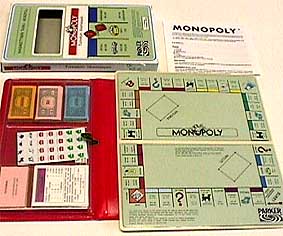 Edition:
Magnetic Pocket, red folder,
barcode nr. 440235 Edition:
Magnetic Pocket, red folder,
barcode nr. 440235
Publisher: Parker Bros./Gilco Ltd./PlayMix - Vantaa - 1991
Dimensions of the unfolded little board: 176 x 216 mm
The game:
Although the year 1985 is mentioned on the little game board as latest copyright
year this variant was not published until about 1991,
because all specific
editions were manufactured in Japan those days.
The little game board is in a red
folder the size of a pocket diary. This folder fits in a jacket with
window in the front. The gold colored
Monopoly bar of the folder shows up in
this window when storing it up. All attributes fit a holder of transparent
plastic. The sizes of all
parts are small, namely of:
Only the 8 tokens, the green houses
as well as the red hotels are flat
squares sticking to the board. However, no provisions have been made for the
money and cards so these have to be kept in hand?
A not very practical game that however have to be present in a collection.
The price amounted to FIM 53,- (€ 9,40) August 1995.
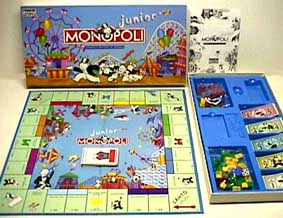 Edition:
Junior - Finnish, ref.054106/SF/2.92 Edition:
Junior - Finnish, ref.054106/SF/2.92
Publisher: Tonka/Hasbro Brio Scandinavia - Vantaa - 1992
Dimensions of the box: 23.5 x 46.0 cm
The game:
Like in the game for adults the aim is to earn as much money as possible. The
moment a player has spent all of his money the other players
must count their
money to see who has won.
The board's back is blue
like the plastic insert of this long box. The board is folded
vertically. Th bottom of the box shows a black/white
picture of the
board and all attributes. The money consists of one-sided printed notes
of 1 till 5 with Herra Pennosen (Uncle Pennybags)
in
various situations.
Four kids can play at the same time, because there are 4 cars, resp. yellow,
red, blue
and green. The ticket booths
that have to
be distributed amongst the players with the same
color of car. The game is said to be a A thrill-filled day at the Amusement Park and
will be
over in about 20 to 30 minutes. You travel with Herra Pennosen to the Roller
Coaster, Magic Show, Water Chute, the Video Arcade and more. In the coarse of
the game ticket booths can be bought to place on an Amusement so that it
becomes your property. If you also own the other Amusement of the same color,
one has to pay double the amount shown on the space. There are 6 Chance
spaces where cards can be drawn with instructions like "Go to the water
Chute" and "Pay 3 mk and take the fair-train to the WC". The
sizes of these cards are 55 x 84 mm.
This set was "Made in Ireland".
The price amounted to FIM 219,- (€ 38,60) August 1995.
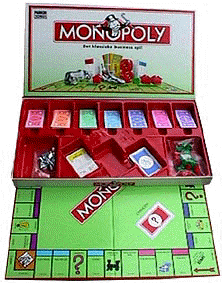 Edition:
Standard, ref. 06951SF Edition:
Standard, ref. 06951SF
Publisher: Parker Bros./Hasbro Scan.AS - 1993
Dimensions of the box:26 x 51 cm
The game:
This is an edition of the Ireland works. Therefor it has, like the sets
of all other European countries, the 4th side of the board on the lid
with the collection of attributes on top of that in a green
background.
The back of the board is red, like
the plastic insert of the innerbox. Sloping over the light
green midfield now is the red bar
with Monopoly in white characters, while Uncle Pennybags is coming out the
central O.
The bottom side of the box shows the well-known color picture of the laughing
family mainly looking to eachother rather than to the game.
The back of the Sattuma cards has a red
print with ?, while the Yhteismaa
cards are printed blue with the
well-known treasure chest in a circle.
The 10 tokens of heavy metal ("made in China") are resp.:
hat - wheel- barrow - shoe - car - canon - rider-on-horse - thimble - iron -
boat and dog. The green
plastic houses do have a chimney the red
hotels haven't.
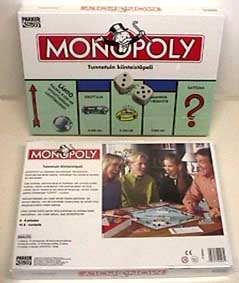 Edition:
Standard, ref. 14535/109 Edition:
Standard, ref. 14535/109
Publisher: Parker Bros./Hasbro DK - 1996
Dimensions of the box: 26.8 x 40.3 x 5.3 cm
of the game board: 25.2 x 25.2 cm
The game:
(The number 109 in the reference is Hasbro's country number for Finland).
Striking of this edition are the new sizes of the box. Hasbro let us know
this has to do with the "standardisation" of the dimensions of their
games.
So herewith disappearsthe long box till so we've called standard
far. The dice on the lid still show 3 and 5.
In this new box is one red plastic tray with
different shaped holes for the money and property deeds of the
bank. The game board is folded in four.
Its back is red,
the play side is blue green.
The game has been manufactured in Ireland so it has again the picture of a
laughing family on the bottom. On the game board are the nice
Sattuma-
and Yhteismaa cards of this edition.
The banknotes are of the new model, i.e. with a black banner
showing "Monopoly with Uncle Pennybags" on top the circle and, hardly
readable,
the remark "1996 Tonka Corporation".
The prices of the properties have never been changed and so you still receive
4,000 mk over Lähtö.
The 10 tokens are of pewter (without the mention "made in China").
The green, plastic houses do have a
chimney, the red hotels
haven't.
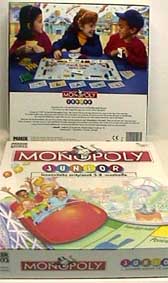 Edition:
Junior - Fins, ref.14540/109 Edition:
Junior - Fins, ref.14540/109
Publisher: Parker/Tonka Corp./Hasbro Scandinavia A.S. - 1996
Dimensions of the box: 26.8 x 26.8 cm
The game:
(Do you see that now Monopoly is again written with a y?)
The differences between this version and the one of 1992:
 |
A totally new square box. |
 |
A new illustration on the cover: Children in a roller coaster cart
with 2
jumping dolphins in the background. |
 |
The color picture on the bottom of the box shows a scene again of
2
(different) girls and a boy. The money they use is that of the 1991
game. |
 |
Now the game board is oblong: 25 x 50.5 cm. |
 |
The back of the board is red
like the plastic tray in the inner box. |
 |
The money consists of 5 banknotes (47x92 mm) with different
illustrations of Herra Pennosen (Uncle Pennybags)
in color on white paper,
i.e.: 1
- 2 - 3
- 4 and 5
mk. |
 |
The Sattuma (Chance) cards have become much smaller in size: 43
x 63 mm. |
The price of this set amounted to FIM 159.- (€ 28.90)
April 1999. This issue is now also "Fabricado na Irlanda".
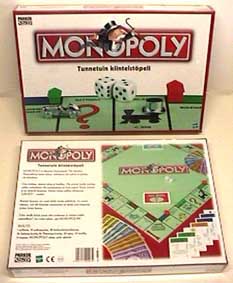 Edition: Standard, ref. 00009/109 Edition: Standard, ref. 00009/109
Publisher: Parker Bros./Hasbro Nordic - DK - 2001
Dimensions of the box: 26.8 x 40.3 x 5.3 cm
of the game board: 25.2 x 25.2 cm
The game:
Parker/Hasbro are standardizing their games
more and more world-wide (because of what to my opinion becoming the less
interesting for collectors). Now the standard editions of all countries bear
number 9, the number for the American standard editions since the first issues
of 1935.
The design of this new game features:
 |
The illustration on the lid shows a somewhat cheap red
rim. |
 |
Only 4 spaces of the fourth side of the game board are shown in
perspective with 1 house, 1 hotel, still the hat and
the racecar as
well as both dice, however now with 4 and 3
(instead of 3 and 5). |
 |
The perspective red Monopoly bar with
the nice shadow and
Mr.Monopoly with the red bow tie
(until 2000
he was Rich Uncle
Pennybags),
that appears on the lid, the
board game's midfield and all 4 rims of the innerbox. |
 |
The bottom side of the box no longer shows "the laughing
family" but almost the whole game board with all its attrubutes. |
The "banker's tray" of this standard
box is red again and has holes
for 7 banknotes as well as for the property deeds who are still present with the banker.
The game board is folded in four and fits, when stored,
precisely on the banker's tray. The back of the board is as usual red,
the playside is blue green.
On the board the Sattuma cards with red
back and ? as usual next to the Start corner and the
Yhteismaa cards with blue back
and treasure chest next to the Free Parking corner. The cards (56x87
mm) have round corners.
The property cards (56x87 mm) also have round corners.
The banknotes (52x100 mm) are printed on one side only. On top
of the circle on the note is a black ribbon showing "Monopoly with
Mr.Monopoly". At the bottom of this circle is in small characters "©2001 Hasbro
Inc.". The currency is Euro(€) and the denominations are
resp.
1 - 5
-10
- 20 - 50
- 100 en 500
(ref.100 00009 00C0).
Over Lähtö you receive, like with the issues in all other EC countries
€ 200.
The 10 tokens are of light metal and are the well-known: hat -
shoe - car - boat - dog - wheelbarrow - rider-on-a-horse - thimble - iron and
canon.
The green houses
and red hotels
are of non-transparant plastic and all have an overhanging roof with an
excentric chimney.
Both dice are white with black pips.
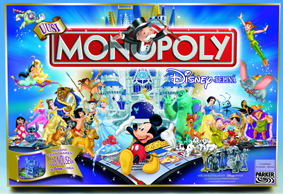 Edition: Uusi
Monopoli Disney-pelinä - Finnish, Ref.Nr.120519631/109 Edition: Uusi
Monopoli Disney-pelinä - Finnish, Ref.Nr.120519631/109
"Ylös nouseva" (unfolds)
Publisher: Parker/Hasbro
Nordic - DK
- 2005
Dimensions of the box: 27.0 x 40.2 x 6.5 cm
The game:
Again Parker/Hasbro
introduces something completely new:
a 3D fairy-tale castle opens on
the centre-field of the game board of this Disney edition. It is nice to see,
but I wonder if it plays nice as well?
I know all properties are based on titles of Disney books, but because I
do not own this edition myself and I cannot think up the Finnish names of the
books I hope some owner of this set is willing to report me all the streets?
Except for the 6 (or 8?) standard fairy-tale tokens this edition has a very
special and essential one, viz. Tinker Bell. An additional paper give an
explanation of the Special Rule for this game. In order to make this
edition even more magic you shall introduce elf Tinker Bell:
1. Prepare the game as usual and put Tinker Bell token at the Lähtö
corner.
2. The moment a player throws double Tinker Bell proceeds 1 space. Besides she
jumps over the Tax-, Showtime- and Magic World spaces as well as the Jail
and
Free Parking.
3. When you land on a property owned by another player and Tinker Bell is
staying there already, it is the Banker who pays the rent for you.
4. When you land on a property that doesn't yet belongs to someone else while
Tinker Bell is there already, you'll get the property for free.
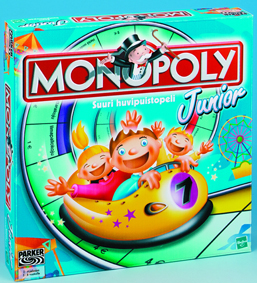 Edition:
Monopoly Junior - Finnish, Ref.Nr. 00441/109 Edition:
Monopoly Junior - Finnish, Ref.Nr. 00441/109
Publisher: Parker/Hasbro Nordic - DK -
2005
Dimensions of the box: 26.8 x 26.8 cm
of the oblong board: 25 x 50.5 cm
The game:
The Junior editions remain unchanged over the years as far as its principles are
concerned. So the only thing the maker can do
is to put all items in a box with a new design. And indeed it has a nice and fresh
appearance.
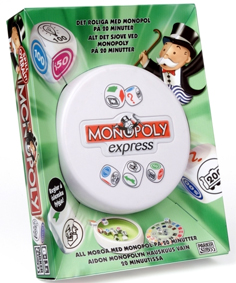 Edition: Monopoly
express, Ref. Nr. 030642787/179 Edition: Monopoly
express, Ref. Nr. 030642787/179
"Aidon Monopolyn hauskuus vain 20 minuutissa"
Publisher: Parker/Hasbro Nordic - DK - 2006
Dimensions of the box: diam. 15.5 cm x 4.5 cm
The game:
Note: Hasbro's Country Number 179 (in the games' Ref.Nr.) stands for
"all Scandinavian countries".
This game is just an other presentation, though a nice one, of the Dice
game, like f.e. ref.nr.14087F, issued in 1992 in France and ref.nr.44029
issued in the UK in 1993.
As the subtitle says: The whole Monopoly pleasure can be enjoyed with this game
in but 20 minutes. There are 11 dice showing not only figures
from 50 to
500 but also locomotives and policemen.
On your turn, throw all the dice as many times as you wish to get as many
"streets" of the same color and so get the highest score you can.
However, if you throw all three policemen, your turn ends and you lose all the
points for that turn.
This edition is "Made in China".
 Edition: Monopoly
Tässä ja nyt - versio, Ref.Nr. 050600114/109 Edition: Monopoly
Tässä ja nyt - versio, Ref.Nr. 050600114/109
(Here and now - version)
Publisher: Parker/Hasbro Nordic - DK - 2006
Dimensions of the box: 27.0 x 40.2 x 6.5 cm
The game:
This Finnish edition of the world wide launched new "Here
and Now" design came almost a year later than the corresponding
German
issue, but as I still believe, that country had to take the lead in the
development of all different versions as there are:
 |
"Here and Now" with red
car showing Mr. Monopoly at the wheel. Some editions have "MR.
M70" on the licence plate,
meaning
"Mr.Monopoly's 70th birthday", but in other
countries the licence plate only show the word "Monopoly". |
 |
"Here and Now" with red
car on the electronic banking issues using credit cards and
a card reader. |
 |
"Here and Now" with Mr. Monopoly in a red
helicopter showing the credit cards to be used with
the card reader belonging to
this electronic banking version. This is the design
of this Finnish edition. |
The motto for this 70th anniversary
edition was for all countries "How would Monopoly look like should it has been invented today?".
Some countries used this motto for the title of the edition, like France
with "Et si Monopoly était inventé aujourd'hui? (see also chapter www.muurkrant.nl/monopoly/france_-_2005_-_New_streets.htm).
Other countries used names identical to this Finnish one like "Here
and Now" in England, "Itt és most!" in Hungary and
different like the "Van Dam tot Dom" in the Netherlands.
For these editions the streets have been substituted by
very well-known (large) objects like buildings, stadiums and monuments. The
amounts have been made "contemporary" as well. So you will not collect
€ 200 over Lähtö , but € 2 million instead, so a factor 10,000 more.
However, everything is of course correspondingly more expensive: The purchase price
for a station became f.e. € 2 million. Is there any reason why all those
useless nils have been applied?
For all
corresponding editions applies in addition:
 |
The game board's background is silvery
grey. Its back is black. |
 |
The Yhteismaa spaces show a modern black chest, filled up with (yellow)
gold rods. The grey background of the Sattuma
cards has a red ?. |
 |
The Lisävero (Special Tax)-space show a more modern goldring with
3 red stones. |
 |
The mortgage side of the property deeds (56x87 mm) is grey. |
 |
A banker's
tray, a dark blue plastic insert in
the innerbox, containing a.o. special slots for property deeds and credit
cards. |
 |
The blue
green houses are ellipse shaped and 6 mm in height. They have no
pointed roof and are stackable. |
 |
The red
hotels have the same shape but are 31 mm in length. Since they
are hollow they are very light and because of that not very practical.
Neighter it is clear what the purpose of the stackability of these hotels
can be. |
 |
The 6
metal tokens are: a skateboard - skeeler - racing car - mobile - money
bag and airplane.
Besides
some countries has an additional token characteristic for the
country. However this Finnish edition hasn't one. |
 |
Six Parker/Visa
credit cards are packed together with the Visa card reader,
all "made in China". Credit cards replace the banknotes (which can
be ordered should you like to have them as yet). All winnings and spendings
are booked per player in the card reader unit. |
 |
Both dice are white with black pips. |
 |
A richly illustrated Rules booklet of 15 pages goes
with this edition. |
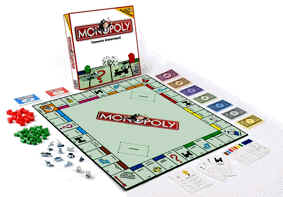 Edition: Standard
- Square box, Ref.Nr. 050600009/109 Edition: Standard
- Square box, Ref.Nr. 050600009/109
Publisher: Parker Bros./Hasbro Nordic - DK -
May 2006
Dimensions of the box: 26.8 x 26.8 cm
of the game board: 25.2
x 25.2 cm
The game:
Instead of issuing a reprint of the standard box from 2001 Parker Bros./Hasbro
decided in all their wisdom, for some misterious
reason, to issue a new sized
box with the same ref.nr. 00009 already in use for the standard edition.
It looks like the standard edition will from now on be in the square box?
Accept for the new sizes all the rest is exactly the same.
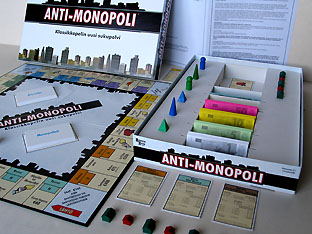 Edition: Anti-Monopoli®, Ref.
24001 Edition: Anti-Monopoli®, Ref.
24001
"Klassikkopelin
uusi sukupolvi"
Publisher: Suomen
Pelimiehet Oy/University Games-NL - 2006
Dimensions of the box: 26.8 x 40.2 cm
The game:
On the bottom of the box is, next to a color picture of the game, a short explanation of the origin of the game and
how to play it.
The translation of the Finnish text reads:
"The Anti-Monopoli is a first big step
forward in the famous Real Estate Game which was originally invented in the year
1910.
Atlantic City Quakers developed
this game to its current shape, and
since then it has become a huge sales success worldwide.
The Anti-Monopoli is based on a new revolutionary idea of a game.
In other games the players follow the common rules,
which
allow all players an equal opportunity to win the game.
The Anti-Monopoli players follow, however,
the two different rule
combinations where some are the monopolists and
others their competitors. In spite
of the different rules it is a fair game for all
players as the chances to win
have been mapped with a help of computers.
Professor Ralph Anspach invented the game and Professor Irvin Henzel
performed the necessary calculations.
The system of two rules makes the difference of the monopolists and the
competitors."
Ralph Anspach is a Professor Emeritus of Economics
at San Francisco State University who invented this Anti-Monopoly game. He based
his creation on the monopoly folkgame which was invented by
Elizabeth Magie in 1904 and was played extensively in the Eastern United States
between 1904 and 1935. Players in the monopoly folkgame buy and trade properties
to monopolize color groupings.His game transforms the folk game into a battle
between competitors and monopolists and it retains the antimonopoly message of
the creators of monopoly. Quaker teachers (members of the Society of
Friends in Atlantic City, N.J.) transformed the folkgame into what is now played
as Monopoly.
Charles B. Darrow stole the knowledge of the game and its rules from these
Quakers, commercialized it, and falsely claimed that he had invented it to
get an invention patent. He licensed it to Parker Brothers which popularized the
legend of Darrow the Inventor.. .
Ralph Anspach discovered the truth about the history of Monopoly when he
became a defendant in a ten-year long law suit filed by Parker Brothers. He
eventually won that law suit, read his book "Monopolygate".
Anti-Monopoly®'s specialty is, as said, its principle
players have to choose between 2 play methods: that of the Monopolists
and the Competitors. However, which part you will prefer, all players
have equal chances to win, although they play according to different
Rules. So Monopolists for example, can only build houses and hotels when
they have a monopoly position in a town (what is the case
already when the
player owns 2 of 3 streets), while Competitors may build on each property,
independent of they own a whole city or one single street.

On the solid board with black back the streets of 8 cities
are from Lähtö onwards:
Rooma: Corso Impero - Kilpailija tai
Monopolisti - Via Roma - Tulovero (Income
Tax)
Berliini: Alexanderplatz - Kilpailija tai Monopolisti
- Kurfürstendamm - Potsdamer Straße
Kiertoajelu/Hintakilpailu(price war)/Vankila
(Jail)
Turku: Linnankatu - Sähkölaitos (Electric
Company) - Vanha Suurtori - Aurakatu
Helsinki: Senaatintori - Kilpailija tai Monopolisti
- Esplanadi - Mannerheimintie
Anti-Monopoli säätiö (Anti-Monopoly foundation)
Pariisi: Rue
la Fayette -Kilpailija tai Monopolisti - Rue de la Paix -
Champs-Élysées
Brysseli: Grote Markt - Hoogstraat -
Kaasulaitos (Gas company) -
Nieuwstraat
Monopolisti: Mene vankilaan (Monopolist: Go to Jail) /
Kilpailija: Mene hintakilpailuun (Competitor:
Go to the price war)
Lontoo:
Park Lane - Piccadilly -Kilpailija tai Monopolisti - Oxford Street
Ateena: Kilpailija tai Monopolisti
- La Plaka - Omaisuusvero (Property
tax) - Syntagma
Note that Finland has two cities occupying the whole second side of the
game board, having chased Madrid and Amsterdam.
The 4 spaces in the middle of each side are respectively: Lentokenttä - Rautatieasema
- Kuljetusyhtiö and Linjaautoasema.
The 3 corner spaces clearly have different meaning for the Monopolists and the
Competitors.
The bottom part of the box contains a white cardboard insert foulded such
a way that a lower part between two platforms can be used as bankers' tray and
store for the houses and hotels.
There are no Chance- nor Community Chest cards in this game but 2x25
plain, white cards Monopolisti and Kilpailija
instead, all with funny illustrations and always with detailed comment, like:
On the Kilpailija cards:
 |
Hallitus on pannut tuulemaan ja Kilpailuvirasto on
tiukentanut kilpaililainsäädäntö määräyksiä monopolistien vahingpksi.
PERI € 25 jokai
selta monpolistilta. =
Congress has finally given the Antitrust Division enough money to enforce
the Anti-Monopolist laws effectively. COLLECT € 25 from
each Monopolist.
|
 | Olet aloittamassa uutta liiketointa. Onnistuuko
riskipitoinen hankkeesi? HEITÄ MOLEMPIA ARPAKUUTIOTA. Jos saat 9 tai alle
liiketoimesi
MENEE MYTTYYN. Jos saat 10 tai isomman luvun niin onnistut JA SAAT € 75
rahastosta. =
You are starting a new business. Will it succeed? THROW THE DICE. If you
get a 9 or less IT FAILS. If you get 10 or more COLLECT € 75
from
treasurer.
|
 | Energian hinnat ovat nousseet pilviin. Kilpailutilanne
estää sinua siirtämästä kohonneita energiahintoja vuokriin
täysimääräisesti. MAKSA € 50. =
The Energy Monopolists have jacked up the price of heating oil.
Competition keeps you from passing on the whole increase to your tenants.
PAY € 50 to treasurer. |
On the Monopolisti cards: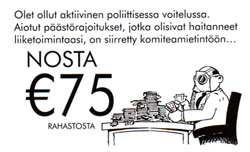
 | Olet ollut aktiivinen poliittisessa voitelussa. Aiotut
päästörajoitukset, jotka olisivat haitanneet liiketoimintaasi,
on siirrretty kominteamietintöön... NOSTA € 75 rahastosta. =
Your political contribution was not forgotten. The smoke pollution
controls which cut down on your profits have
been abolished. COLLECT € 75
from the treasurer.
|
 |
Hyvä Veli - järjestelmä toimii ja sait aikaan kunnun
sopimuksen. Media oli valppaana ja nosti jutun esille. Saatko
pidettyä sopimuksen vai puretaanko sopimus julkisen painostuksen
saattelemana. Jos saat heitettyä kahdella
arpanopalla: 7 tai pienempie luku: EI SOPIMUSTA, 8 tai suurempi luku: myrsky
laantui ennen aikojaan, joten
NOSTA € 75 rahatosta. =
Through a shady deal, you landed a big government contract. But someone
spilled the beans to the press. To
see whether your deal will go through,
roll the dice. If you get 7 or less NO DEAL, 8 or more the storm blew over
and you COLLECT € 75 from treasurer.
|
 | Posti kuljetti lahjoittamasi merkittävän rahallisen
avustuksen vahingossa suurimman kilpailijasi toimitusjohtajalle.
Lahjoitus täytti lahjonnan kriteerit ja sait ansaitut sakot. MAKSA € 50
rahastoon =
You made an illegal campaign contribution to a senator. The press got
wind of it.. Just plead no contest and
PAY a fine of € 50 to
treasurer.
|
It is of course also necessary the two types of players to be taken into
account of on the property deeds. That is why they have 2 columns
for the prices: at the left for the Kilpailija
and at the right side those for the Monopolisti.
The back side of the cards is also to show the property to be mortgaged. In this
situation the card must be given the bank, however, the owner can any
moment buy it back from the bank. This is also said on the back side of the
cards.
There are only 6 banknotes, printed in grey
on colored paper, in the denominations: 1
- 5 - 10
- 50 - 100
and 500.
There are only 6 plastic tokens, viz. of each a green
and blue one: cone, pyramid and a pawn like a "cilinder
with sphere".
The set goes with 35 houses and 15
hotels of plastic, with roof rim and chimney. (Note:
The Kilpailija must place their houses and/or hotels on the name of the field, while the
Monopolisti must situate them on the "H"-spot.)
Both dice are white with black pips.
The first version of this 21st edition was published in 2005 in
the USA, soon followed by that of many European countries.
This edition was "Made in Spain".
The price of this edition was at the introduction € 19.95.
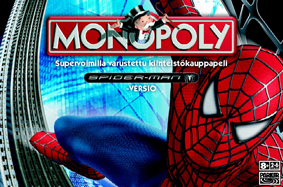 Edition: Monopoly
Spider-man - versio, Ref.Nr. 060753985/109 Edition: Monopoly
Spider-man - versio, Ref.Nr. 060753985/109
"Supervoimilla varustettu kiinteistökaupapeli"
Publisher: Parker Bros./Hasbro Nordic - DK -
July 2007
Dimensions of the box: 40.3 cm x 27.0 cm x 6.5 cm
The game:
Because I do not have a copy of this edition I can only let you
know how the publisher introduces the game:
"The fate of the city is in your hands. Spider-Man is in a race to the
finish as he web swings across the city trying to outbid Goblin 2, Venom and
Sandman. The villain's plan is to buy, rent and sell everything they can get
their hands on, but can Spider-Man outsmart them at their own game? The one with
the most money in the end will control it all.
Includes six collectible Spider-Man themed tokens # Spider-Man in three
different poses, Goblin 2, Venom and Sandman."
The cards are common Sattuma-
and Yhteismaa-
cards,
while the houses are apartments, the hotels skyscrapers.
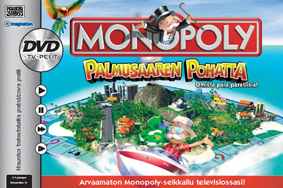 Edition: Monopoly
- Palmmusaaren Pohatta - DVD - Art.no. 52479/106 Edition: Monopoly
- Palmmusaaren Pohatta - DVD - Art.no. 52479/106
"Omista
pala partiisia!"
Publisher:Parker Bros./Hasbro Nordic - DK -
2007
Dimensions of the box: 40.3 cm x 27.0 cm x 6.5 cm
The game:
It would be very well appreciated if an owner of this
edition could supply me with the details to be published here!
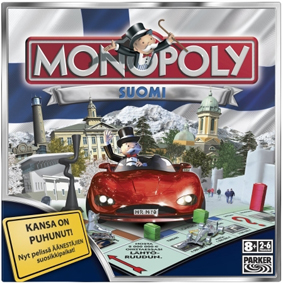 Edition: Country
version: Suomi - Square box- Ref.Nr. 01603/106 Edition: Country
version: Suomi - Square box- Ref.Nr. 01603/106
"Kansa on puhunut!"
"Nyt pelissä ÄÄNESTÄWEN suosikkipaikat!"
Publisher: Parker Bros./Hasbro Nordic - DK -
2008
Dimensions of the box: 26.8 x 26.8 x 5.4 cm
of the game board: 25.2
x 25.2 cm
The game:
I was very surprised to recognize the "Tässä ja nyt" design of
a few years earlier, but now with Mr. Monopoly driving a red
car with the very special license plate bearing number "MR.
M70" (meaning Mr.Monopoly 70 years of age). However, on second glance the
Finnish
flag is to be seen, hidden behind the red
Monopoly bar. And at last it appears this issue to be a "Finland edition"!
The picture on the lid will doubtless be a compilation
of buildings easilly to be recognized by the Finnish voters.
This all means the game board has new street names composed of cities
from all over the country.
All properties of this new issue are from Lähtö onwards:
Turenki - Yhteismaa (Community
Chest) - Kuhmo -
Tulovero (Income Tax) - Pasilan Asema -Lahti
/ Lahtis
- Sattuma (Chance) - Seinäjoki
- Seinäjoki - Vankilassa käynti (In
Jail) - Pori
/ Björneborg -
Sähkölaitos (Electric Company) - Jämsä
- Kuopio - Sörnäisten Asema
(a MetroStation)
- Espoo
/ Esbo - Yhteismaa - Kouvola
- Kangasala - Vapaa Pysäköinti (Free
Parking) - Tornio
- Sattuma
- Forssa - Lohja
/ Lojo - Rautatie Asema (Railway Station) -
Loimaa
- Lappeenranta
/ Villmanstrand -
Vesijohtotaitos (Water Works) - Hämeenlinna
/ Tavastehus - Mene vankilalaan (Go to Jail) -
Järvenpää / Träskända
- Kajaani / Kajana - Yhteismaa -
Savonlinna / Nyslott - Tavara-Asema (Freight station) - Sattuma -
Tampere
/ Tammerfors - Lisävero (Special Tax) and
Hamina.
Notice that a number of towns also have a Swedish name.
All items like the banknotes, houses
and hotels, dice and tokens
are the same as in "Tässä ja nyt".
SELF - MADE GAMES
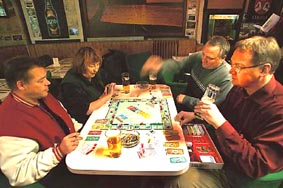 Edition: Kalliopoly Edition: Kalliopoly
Makers: Jouni Kontiala and Maija Sohlman - Oct.2003
Dimensions of the board: Standard Monopoly board, covered with prints of our own.
The game:
Jouni Kontiala remarks about this game with streets of the Kallio district
of Helsinki, this esotheric version of Monopoly should better not be published
because it is a rather naughty one, only to be played on the KultaPalmu bar
in Helsinki:
"The word 'Kallio' means 'high rock'. Kallio used to be a district for labour-class and that has left some traces
on the atmosphere.
Nowadays a lot of students live here. That's due to the fact that apartments here are small, usually 20-40
m2.
There are no big shops in Kallio but a huge amount of
1) tiny pubs
2) thai-massage-services.
No one has ever seen anybody going into the latter ones, but somehow they manage.
We also have the privilege to have the most known girl-street (Aleksis Kiven
Katu) of Helsinki were girls from Russia or Estonia offer their services.
Finally Kallio has the reputation for a place where you can buy drugs or
illegal liquer. But, as a matter of fact, that's only a reputation.
Things used to be like that, but during recent years the streets of Kallio have cleaned up.
This is the atmosphere that gave me the idea to make 'an adult version' of Monopoly, a version which includes also the darker sides of life.
But always treated with humour."
The Kallio district streets are from Lähtö
(here: Kultapalmu) onwards:
Helsinginkuja
- Ensi linja - Sörnäisten Metroasema
- Kustaankatu - Harjukatu
- Harjutori (sauna)
- Hangonkadun Katkolla/REHAB - Kirstinkatu - Castreninkatu
- Alppikatu
-Karmulaston Taksiasema
- Toinen Linja - Kolmas Linja
- Neljäs Linja - Vapaa Roskalava (Free
Parking) -
Agricolankatu
- Kaarlenkatu - Viides Linja - Hesarin
Taksiasema
- Pengerkatu
-
Porthaninkatu
- Fleminginkatu
- Mene Katkolla - Sturenkatu - Aleksis Kiven katu
- Hämeenkatu - Aleksis Kiven Kadun
Tavara-asema -Helsinginkatu
and Vaasankatu (where
KultaPalmu pub resides).
The basis for this edition was a standard game board on which stickers
with the new street names were pasted. Like this the standard property deeds
and cards were used to stick the new names and instructions on. These were
plastized afterwards in order to make them durable for occasional beer-baths.
The instructions of some of the cards read:
 |
Take empty bottles from your home to re-cycling.
You get 500 euros for the bottles. (in Finland you get 10 cents per bottle when taken to
re-cycling) |
 |
You've been infected in Aleksis Kiven katu.
Pay the doctor bill, 1000 euros. |
 |
Your tax-fraud has succeeded. You get back 3000 euros. |
 |
You win the Karaoke-competition in KultaPalmu.
Your 1st prize is 2000 euros. |
 |
Your Viagra-bill. Pay 2000 euros. |
All banknotes of the Standard Monopoly
edition with red border, ref.00009, are used, as well as the houses and hotels.
However, there are special tokens to this set, viz.: nail-clipper - coin
- condom - Mika Häkkinen F1 World Champion 1998 pin - Finnish Mark
silvercoin 1908 - bottle of theaterglue - stapler - film box and Jouni's junior basketball gold medal.
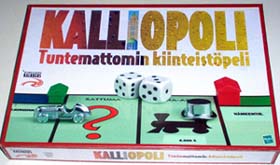 Jouni
gives following additional information to the design of their pub edition: Jouni
gives following additional information to the design of their pub edition:
 | Where the lid of the Standard edition
says
Tunnetuin kiinteistöpeli (The most known real
estate game)
our set says Tuntemattomin kiinteistöpeli (The least
known
real estate game and we are proud of that). However
this latter will
change since it is published in my world wide Lexicon! |
 |
We have replaced the Parker-Swirl
by a Kalkker-Swirl
in order to reduce the resemblance with the wellknown game
manufacturer. |
 |
In Kalliopoly Start-corner is
KultaPalmu, where you get €4000 whenever you visit or pass by.
Unfortunately it's not true in real life, otherwise Maija and I would be millionaires. |
 |
There is no Jail but a Rehab
instead. In Kalliopoly it's the worst possible punishment if you can't have
a drink. That is also the idea in the card saying: Go to rehab, go straight to rehab, without going first to KultaPalmu. |
 |
The sauna in Harjutori
is the best Sauna in northern semisphere (and southern semisphere doesn't exist, when talking about Saunas).
The Sauna is heated up with a fire-stove burning 1 m long birch-logs. |
 |
The original houses and
hotels are used, but in Kalliopoly they mean
'a thai-massage' or 'a pub'. |
An interesting newspaper article about this
set can be found at: http://www.helsinginsanomat.fi/english/article/1101978481974
|